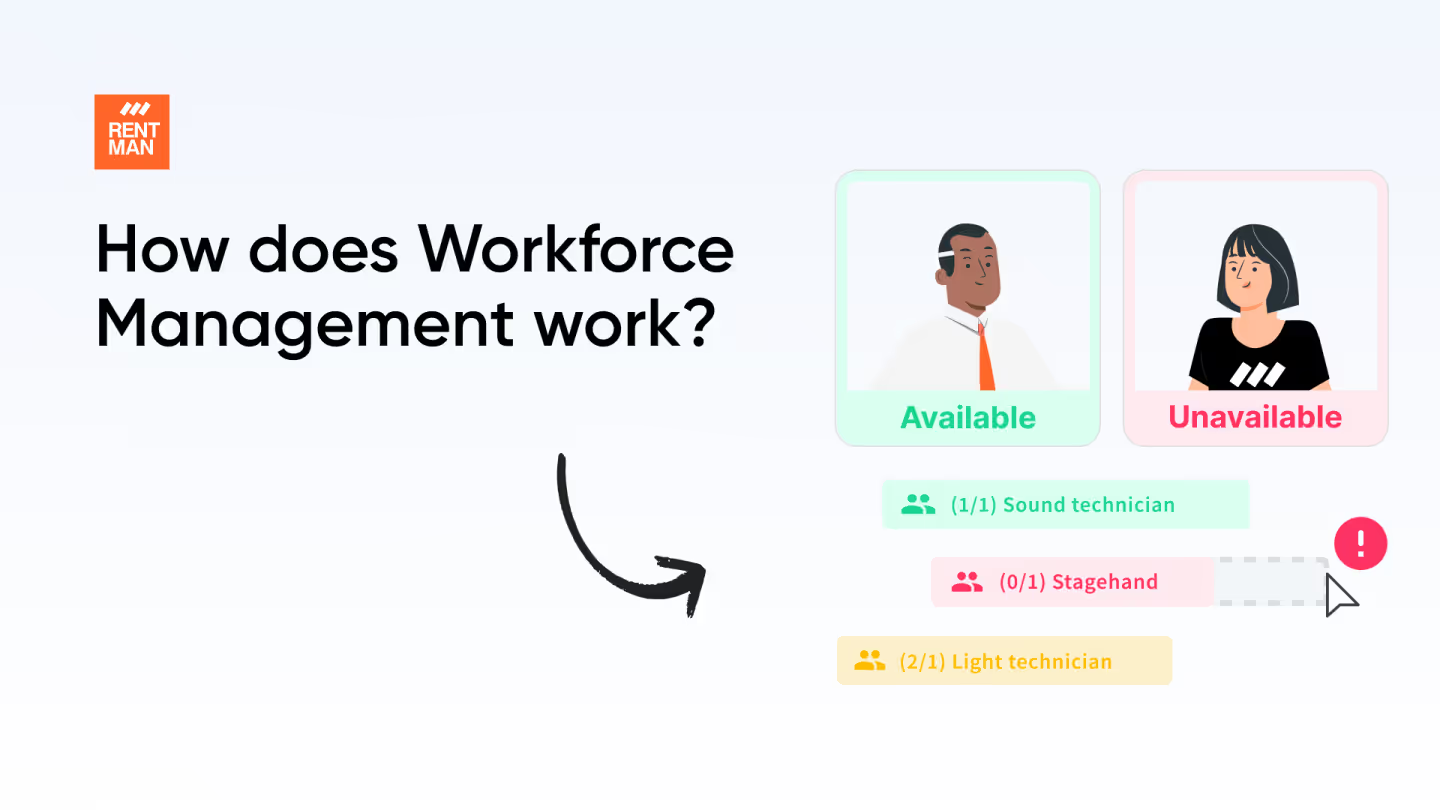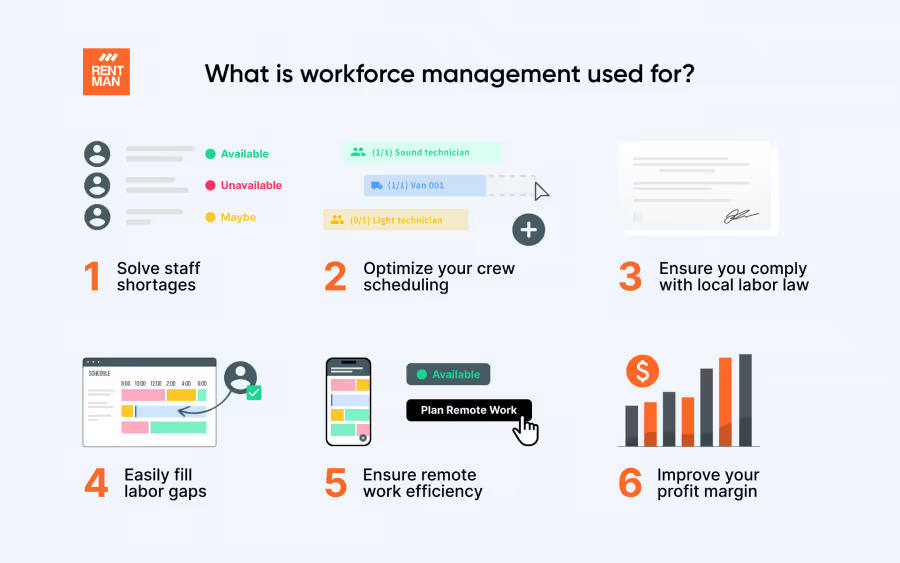Everything you need to know about workforce management

Looking to reduce employee costs, increase efficiency, automate processes, and employee satisfaction and boost team morale? Turns out that many organizations have been searching for such a solution. And they've found it by embracing workforce management solutions.
But what is workforce management? People often explain it as a set of workforce management processes. However, this definition doesn't clearly explain the idea or benefits of it. And how do you create a good workforce management software solution? How can it help your company grow while keeping costs down?
This guide will answer all of this and more, exploring the many workforce management solutions, that can transform your business operations. Here's what we'll go over:
1. What is workforce management?
2. How does workforce management work?
3. Workforce management use cases
4. Problems solved with good workforce management
5. How to use Rentman to manage your workforce
What is workforce management?
Workforce management (also known as WFM), what is a labor force management company is more than just time-tracking your employee's time and completed activities. Instead, it's a strategy that helps event companies optimize their crew and ensure they have the right number of people with the needed skills at all times.
How does workforce management work?
The best WFM system is one that finds the perfect balance between the amount of work required and the amount of staff needed to handle that work. Finding that balance doesn't happen overnight but there are steps you can take to implement a workforce management strategy.
To use your team in the most efficient way possible, start by getting clear on your company's goals, target audience, and industry of operation.
Armed with a clear image of your goals and the types of clients you serve, analyze your current workforce. Does your network of in-house crew and freelancers meet all of your customer's needs? Alternatively, do you have too many freelancers specialized in one area and not enough in another?
Use these answers to determine the type of people you need to fulfill these needs and create a hiring plan to address shortages or potential surpluses.
These steps form the foundation of a successful workforce management strategy. However, gathering this data and manually inputting all of it into an Excel sheet is quite time-consuming. Workforce and mobile workforce management and software can speed up this process by crunching workforce management data for you, helping you create schedules, assess staff needs, and forecast demands.
What is workforce management used for?
Every company has different priorities. But most, regardless of size or industry, generally share a desire to be more efficient and productive than their competition.
The good news is that there are multiple ways of achieving this using workforce management.
Here are the key functions of a workforce management strategy.

Solve staff shortages
Not having the right people on hand for an event will hurt your business reputation and lead to last-minute stress and work.
A workforce management system enables you to avoid the fear of potentially losing a client or not being able to meet their demands by forecasting your labor needs. Allowing you to proactively address staff shortages and hire the right number of people with the skills you need before a disaster hits.
How? By analyzing your company's historical data, seasonal trends, and market demand, a WFM system enables you to predict when and where these shortages might occur.
Optimize your crew scheduling
Manually creating a schedule in Excel and keeping it updated as the scope varies or a freelancer's availability changes is time-consuming.
That's why you need a system that takes into account variables such as vacation, availability, workload, and absences to create a schedule that works for the entire team.
Workforce management software uses inputted event information and employee data, such as availability, to create schedules that align with customer needs, streamlining both workforce and talent management. Meaning you can create a schedule in minutes and rest assured you won't be understaffed during critical times or overstaffed when business slows down.
Ensure you comply with local labor law
Accurate time tracking and employee attendance are not just about paying your crew. It's also crucial for legal compliance. Because non-compliance with state, federal, and local employment laws can result in fines and employee lawsuits.
Use WFM tools to keep a digital record in case of potential audits in addition to organizing and tracking employee eligibility, overtime requirements, and leave.
Easily fill labor gaps
At its core, workforce management is used to manage staffing levels and ensure that your company has the right number of employees with the needed skills at all times. However, during peak seasons or if you're faced with a sudden crew shortage, you might turn to external staffing agencies to fill your needs.
WFM systems easily integrate temporary staff into your existing set-up and schedule.
How? By the employee engagement, simplifying the onboarding process and syncing temporary staff schedules with the existing workforce. Ensuring smooth operations without sacrificing efficiency.
Ensure remote work efficiency
A lot of your crew members and freelancers probably don't work on-site. Some may not even be in the country when you're creating an event schedule. And emailing back and forth to chase down their availability and confirm their attendance is much too time-consuming.
A WFM software allows crew and freelancers to access their schedules remotely, update their availability, and communicate with a team lead or project manager from anywhere and at any time. So project managers and freelancers don't need to stay in the office to catch up after hours.
Guaranteeing you have the manpower you need for an event, and assuring everyone is up to date as to requirements and expectations.
Improve your profit margin
For most companies, labor is the greatest expense. Therefore, once you're armed with a powerful crew and network of skilled employees, you'll spend less resources and money recruiting last-minute staff.
Instead, optimize deployment, balance everyone's workload, and incorporate workforce planning into your budget to maximize efficiency.
By efficiently managing your workforce resources, your company can control costs. This control directly translates into improved profit margins.
Problems solved with good WFM
Staying in control of crew planning essential for project success. Workforce management tools allow planners to:
- Ensure real-time access to crew and equipment availability: A clear, real-time view of crew and resources prevents last-minute scrambling, allowing planners to resolve issues proactively.
- Reduce scheduling conflicts and errors: With real-time scheduling, planners can avoid double-bookings and stay ahead of potential conflicts across multiple projects.
- Streamline communication and reduce stress: Consolidating information in a single platform makes it easier to keep everyone informed and prepared, reducing last-minute confusion and creating a more organized workflow.
Better manage your crew and labor costs
Workforce management isn't just about creating schedules or keeping track of hours; it also intersects with human resource management and resources for strategic planning and smart allocation of resources all while ensuring you stay legally compliant with the latest labor laws. Because doing so directly impacts your bottom line.
Workforce and labor management and platform, such as Rentman, enables you to optimize your scheduling process and ensure your entire business runs smoothly.
Conclusion
In conclusion, workforce management is more than a set of processes; it's a strategic approach that empowers businesses to streamline operations, reduce costs, and improve productivity by effectively managing crew and resources. By implementing a robust WFM system, companies gain insights that help them anticipate staffing needs, avoid potential pitfalls, and ensure compliance with labor regulations. This translates to significant time and cost savings, increased agility in handling last-minute changes, and the ability to meet customer demands seamlessly.
Tools like Rentman simplify these tasks by automating scheduling, tracking availability, and forecasting labor requirements, freeing your team from time-consuming manual processes. This enhanced efficiency doesn't just improve operational workflow—it boosts team morale, as staff experience less stress and clearer communication. For businesses in the events industry, where schedules and requirements change frequently, a WFM system is crucial in maintaining a competitive edge.
Ultimately, a well-executed workforce management strategy enables businesses to leverage their most valuable resource—their people—to meet today's demands and adapt to tomorrow's challenges. Embracing workforce management is an investment in your company's growth, stability, and ability to consistently deliver top-quality service.
FAQ
Frequently asked questions
Workforce management (WFM) is the strategy businesses use to ensure every employee is in the right place, doing the right job, at the right time. It's about efficiently forecasting labor needs, easily assigning tasks, tracking who's present while ensuring companies remain compliant with constantly changing workplace laws and regulations.
For example, if you operate an event or party equipment rental, the wedding season will be busy for you. You’ll need experienced staff to handle complex setups like tents and lighting, while simultaneously assigning other employees to manage customer inquiries and administrative tasks. However, outside of these few months, you might have very little work. Workforce management enables timely temporary hires to ensure you can meet customer demands while ensuring you keep labor costs lower during slower months.
Workforce management software is like a digital assistant for your business. It will simplify and automate tasks such as scheduling or organizing assignments while enabling remote collaboration and labor deployment.
Workforce planning means having the right skilled people in the right places when needed to achieve your company goals and given assignments.There are six key elements to workforce planning: strategic direction, workforce analysis, supply analysis, demand analysis, gap analysis, solution implementation
Workforce management (WFM) and human resources (HR) are two separate terms that are often used interchangeably. Workforce management is a strategy that often uses a tool or software to help businesses better manage their team of employees. Human resources refers to the overall management of people and their well-being within a company.
Workforce management is a subset of HR that focuses on one aspect of a company’s workforce. HR is a broader term that encompasses many activities related to managing your employees and their well-being.
Workforce management involves multiple skills such as planning, scheduling, forecasting, and monitoring each employee’s activities to optimize your company’s efficiency.
Previous blog posts

How a serial number works and why you should use it
How a serial number works and why you should use it

How to set Asset Tags for your Equipment: A Comprehensive Guide for Rental Businesses
How to set Asset Tags for your Equipment: A Comprehensive Guide for Rental Businesses

